Rossella Vanon shares her top tips for taking and editing beautiful fashion portraits
Fashion and photography enjoy a symbiotic relationship. When a designer or cosmetics company launches a new range, imagery plays a key role in promoting the garments or products and their associated lifestyles. These images could be designed to glamorise, provoke or inspire, and are by no means limited to the pages of glossy fashion magazines – shop windows rely on striking promotional imagery to encourage shoppers to step inside and browse. Fashion and beauty photographers, therefore, have an essential part to play.

There are so many elements to consider when it comes to fashion and beauty portraits. Canon EOS 5D Mark II, 100mm, 1/160sec at f/10, ISO 100
As genres they’re subtly different – one sells clothes, the other cosmetics – and each requires a subtly different skillset, but one photographer who has mastered both is Rossella Vanon. London-based Rossella is renowned for her use of vibrant colours and precision lighting and loves the creative freedom fashion and beauty allow. ‘There are many different elements that I can plan, mould and change until, like pieces of a puzzle, they all work perfectly with one another and a beautiful final image is obtained,’ she says.
From makeup, hair and clothes to lighting, sets and accessories, there are many different elements to a successful fashion or beauty shoot, and it’s a process that often involves a team of stylists and creatives. With so much to consider and synchronise, we teamed up with Rossella to bring you a unique behind-the-scenes insight into how important the planning, shooting and editing stages are…
Planning fashion portraits
Studio photography is an anomaly in the sense that the photographer has full control over every aspect of the end result. With landscape or wildlife photography, for instance, you can plan for the location, time of day and technique, but you’re still at the mercy of the weather and/or the subject’s personality or kittishness. This makes meticulous planning all the more important for fashion and beauty, as it’s essential that everyone involved knows exactly what’s expected and what the end result should look like. ‘In the planning phase, we want to pinpoint as clearly as possible the kinds of images we want to obtain from the shoot and outline the steps we need to take to create those shots. ‘
The initial inspiration could come from anywhere – it can be another image, a colour palette or even a model you would really like to photograph. This initial inspiration is key to jumpstarting the planning process, but it’s just the beginning. What we want to do next is develop this idea as much as possible, so that it isn’t just a general outline, but a detailed and comprehensive plan of action.’ Pinterest is a go-to source of inspiration for Rossella and a great place to discover new and exciting colour schemes that could potentially work as makeup colour palettes for beauty shoots. Once she’s found a colour or style that excites her, she then starts to narrow down her initial ideas and think about whether it will work for a spring/summer or autumn/winter beauty shoot.
She’ll research current seasonal beauty trends and, based on what she finds, decides what specific type of makeup to focus on. ‘This could be bold lipsticks or metallic eyes.’ With the type of makeup determined, Rossella then turns her attention to other aspects of beauty such as hair, nails and clothes, before deciding on a specific style based on the kind of images and moods she wants to create. ‘I then make a mood board for each of these elements and email it to the creative team to give them a visual reference guide for the shoot.
Remember that although planning is absolutely essential, you will always have to adapt your initial ideas to suit the subject, their features, skin tone, hair colour and other important characteristics.’ Shooting With meticulous planning comes well-structured shoots that run smoothly and without a hitch. And with time being such a precious commodity – makeup artists and stylists aren’t cheap – Rossella’s inspirational mood boards ensure that everyone involved understands the visual style before a single photograph has been taken. She even creates a mood board of suitable poses, which she prints out and keeps close to the model at all times. Rossella is just as meticulous when it comes to kit, and first on her studio checklist is lighting.
‘I start every shoot day by making sure I have all the lighting equipment I need and that it is functioning. Then I sit down with the creative team and, together, decide on the order of all makeup/hair changes. I also sit down with the model while she’s in makeup and chat to her, break the ice and show her the mood boards and discuss the kind of mood and poses I’m looking for.’ The main challenge of any fashion or beauty shoot is making sure that there’s enough of a visual connection between images and looks to create a cohesive photo series, but ‘not too much that there’s too little variation’. This requires attention to detail, which is where technique and teamwork come to the fore. During a shoot Rossella is relaxed and chatty, constantly directing her model, while the makeup artist and stylist are never far away, making almost imperceptible refinements to ensure consistency.
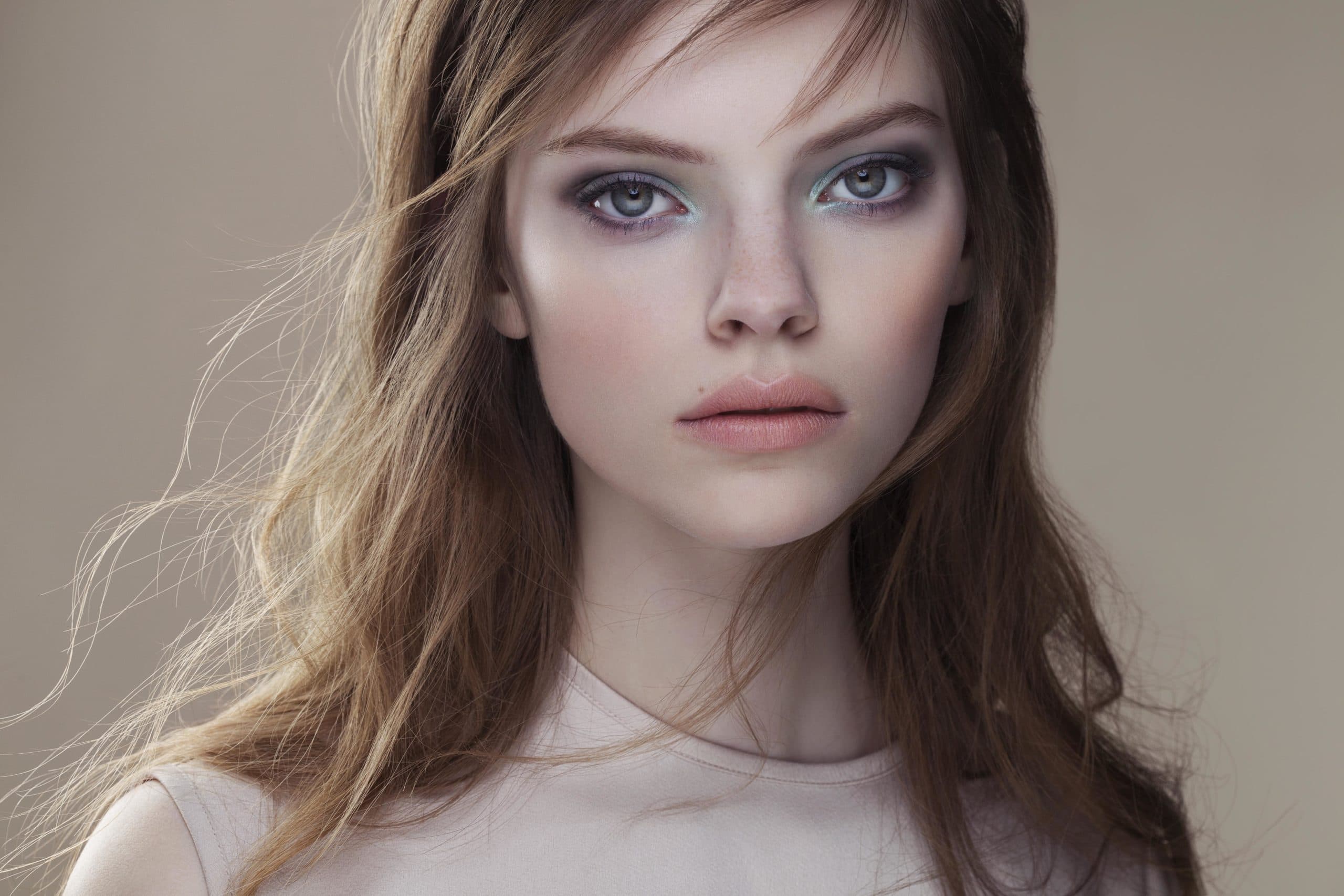
Take the time to connect with your model and talk them through mood boards. Canon EOS 5D Mark II, 100mm, 1/160sec at f/9, ISO 100
‘I like to sit on a high stool when I shoot, especially on beauty projects. It gives me the stability I need to hold my lens steady and focus on small details. I tether to my laptop straight into Capture One so the team and I can see the images on a bigger screen and spot details that would be entirely missed on the camera’s rear display.’ When it comes to technique, simplicity is the key. Rossella’s favourite camera/lens combo is a Canon EOS 5D Mk IV coupled with a Canon EF 100mm f/2.8 Macro USM, a quality prime that affords a comfortable working distance between photographer and model.
‘I’ve used this lens for years – it provides a great amount of detail for a fairly low price tag.’ For lighting, she relies on Profoto heads for their ‘sturdiness and reliability’ and a range of modifiers including softboxes ‘of all shapes and sizes’ and a white beauty dish. As for specific lighting setups, however, this varies according to the brief. ‘I’ve shot with two lights as much as I have with five, and used a simple octabox as much as I have enjoyed playing with coloured gels.’
Editing fashion portraits
One of Rossella’s favourite setups is to place a 5ft octabox 30-45 degrees to one side of the model, with a softbox placed opposite and behind the subject. ‘Sometimes, I even use the octabox on its own – when one light is correctly placed, the results can be beautiful.’ Editing Selecting images doesn’t simply mean choosing your favourites – there are briefs to meet and clients to please. ‘Correctly selecting images means picking strong images that also make a strong series.
And the type of shots I select always depends on the purpose of the shoot. For example, if I’m working for a magazine, I want a series of six or more images where each image portrays a different makeup/hair look, and with enough variety. I also need to make sure that any landscape format images don’t have the subject right in the centre of the frame, or the magazine’s “gutter” will distort it when the shot is printed across a spread.
If I’m working for a client, on the other hand, I may let them take care of the selection phase.’ Rossella has spent years refining her post-processing workflow and even runs an online retouching course. This stage of the process varies dramatically depending on the individual taste of the photographer, the genre and, to a certain extent, the purpose of the shoot itself. ‘My editing workflow is a very important step and I like to use this opportunity to add impactful, tailored colour grading that will add my final signature to the images. I also like to remove distractions from the background, skin imperfections, stray hair and more. The key is to keep it subtle, natural and believable. Looking at the images, no one but me should be able to tell what was edited.’
Editing is an important final step that can put many different spins on any given shot, and it’s important for fashion and beauty photographers to work towards an editing style they can call their own. Rossella’s workflow is different every time, but can be loosely grouped into the following steps: use the Healing Brush tool to remove blemishes; the Dodge and Burn tools to enhance contrast; the Clone Stamp and Healing Brush tools to remove stray or unwanted hairs; apply colour grading layers; apply sharpening if necessary, particularly if shooting with a wide aperture; liquify to subtly enhance shapes such as eyes and lips.
Editing before and after
‘Retouching an image should always start with eliminating small distractions and enhancing already existing details. We can indeed take the editing further and get very creative, but it is this initial step that will make all the difference. That’s exactly what I focused on here.

I removed a few skin imperfections, treated skin tones to remove some of the distracting redness, enhanced eye presence and removed some of the flyaway hairs. It’s all in the details. The key is to know what technique to use and when to stop so we don’t overdo it.’ See the edited shot below.
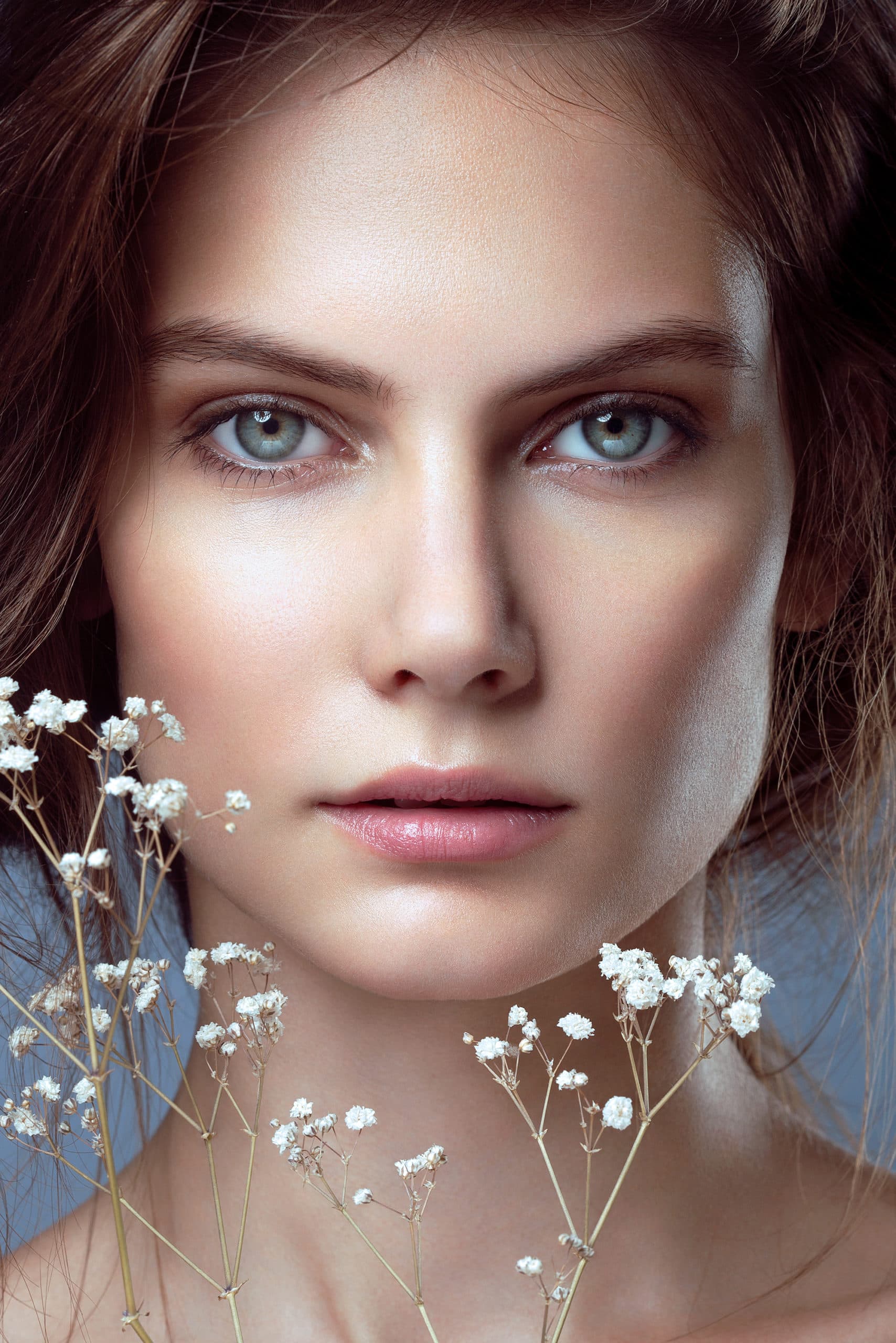
Kit list for Fashion Portraits
Printer
Printing out your mood boards and bringing them with you to the shoot will allow the whole team to have easy access to them for reference throughout the day.
Canon EF 100mm f/2.8 Macro USM
This is Rossella’s favourite lens for close-up portraits and beauty shots. The focal length is long enough to allow for close framing and the macro feature allows her to focus on very close details like lips and eyes for beauty shots.
Photoshop
Rossella uses Photoshop extensively both before, during and after the shoot. She uses it to make her mood boards and edit previews during the shoot, as well as to carry out her entire post-processing workflow.
Wacom tablet
This is an essential item when it comes to fashion and beauty retouching, and it’s especially necessary when you need to edit small details like skin, hair and eyelashes. Using one allows Rossella to be precise and edit seamlessly.
Rosella’s Retouching Workflow
1. Raw image
I start by assessing my shot and identifying any problem areas. I always start from the most problematic area and then work my way towards the more subtle, creative adjustments.
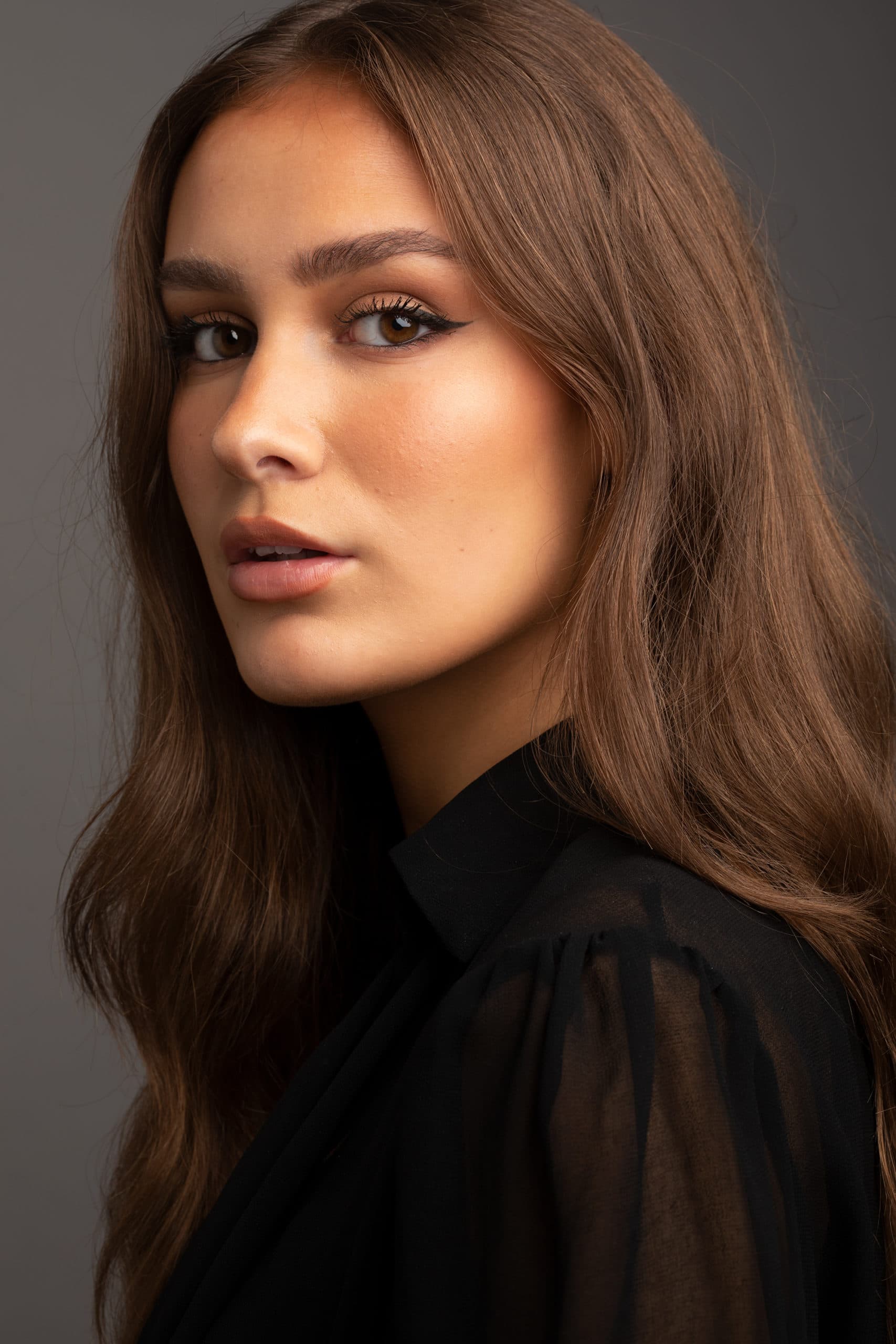
2. Hair
I have assessed that hair is the problem area in this image, so I tackle that first. I use a mix of compositing, Frequency Separation and Dodge and Burn to both fill in and tidy up the hair, and then finish off with a subtle use of Liquify to enhance volume and shape.
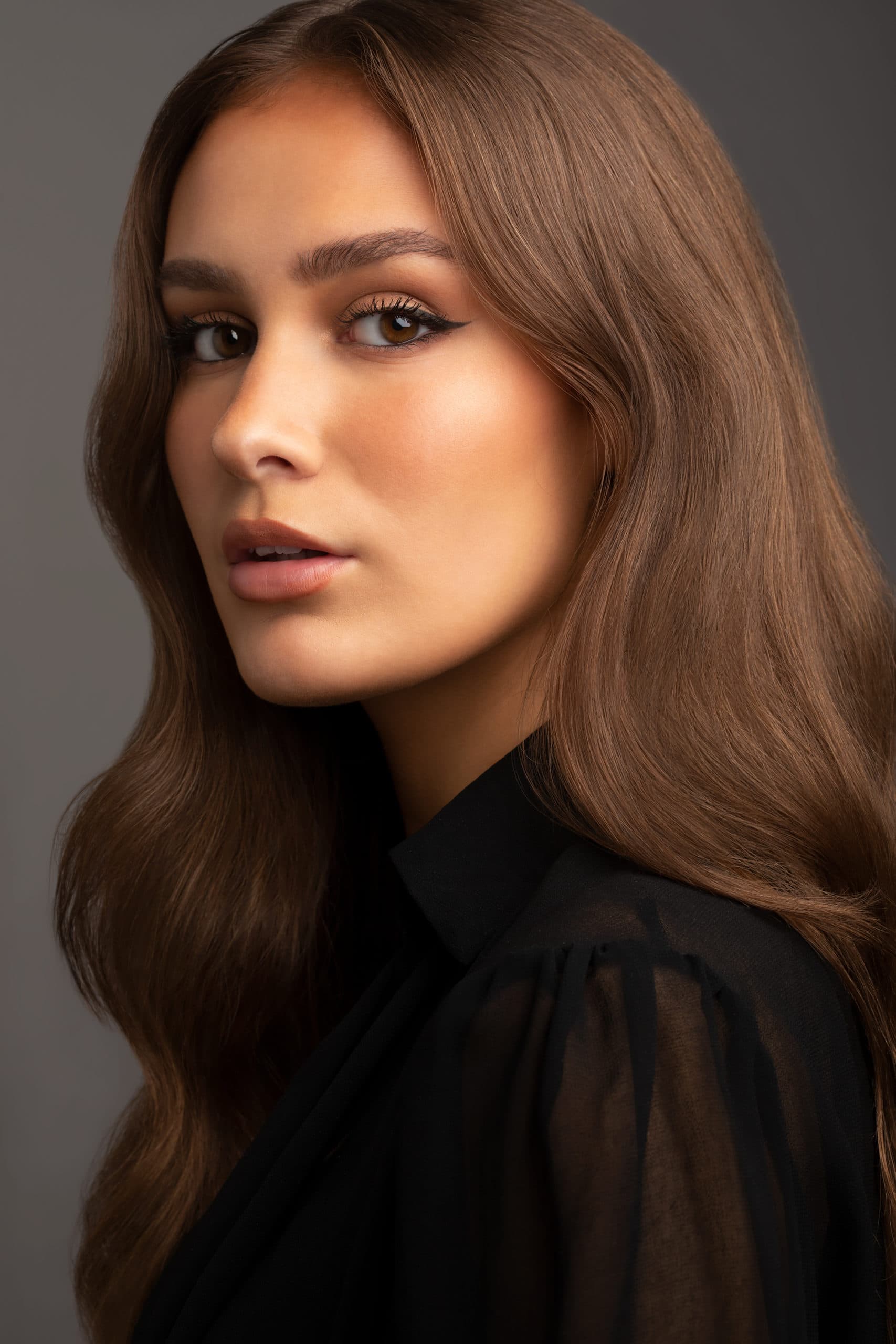
3. Skin
Next, I focus on the skin. I use the Healing Brush to even out the texture and remove imperfections. After, I Dodge the skin to eliminate any dark blotchy areas to make the skin appear smoother. I treat lips at this stage with the same process.
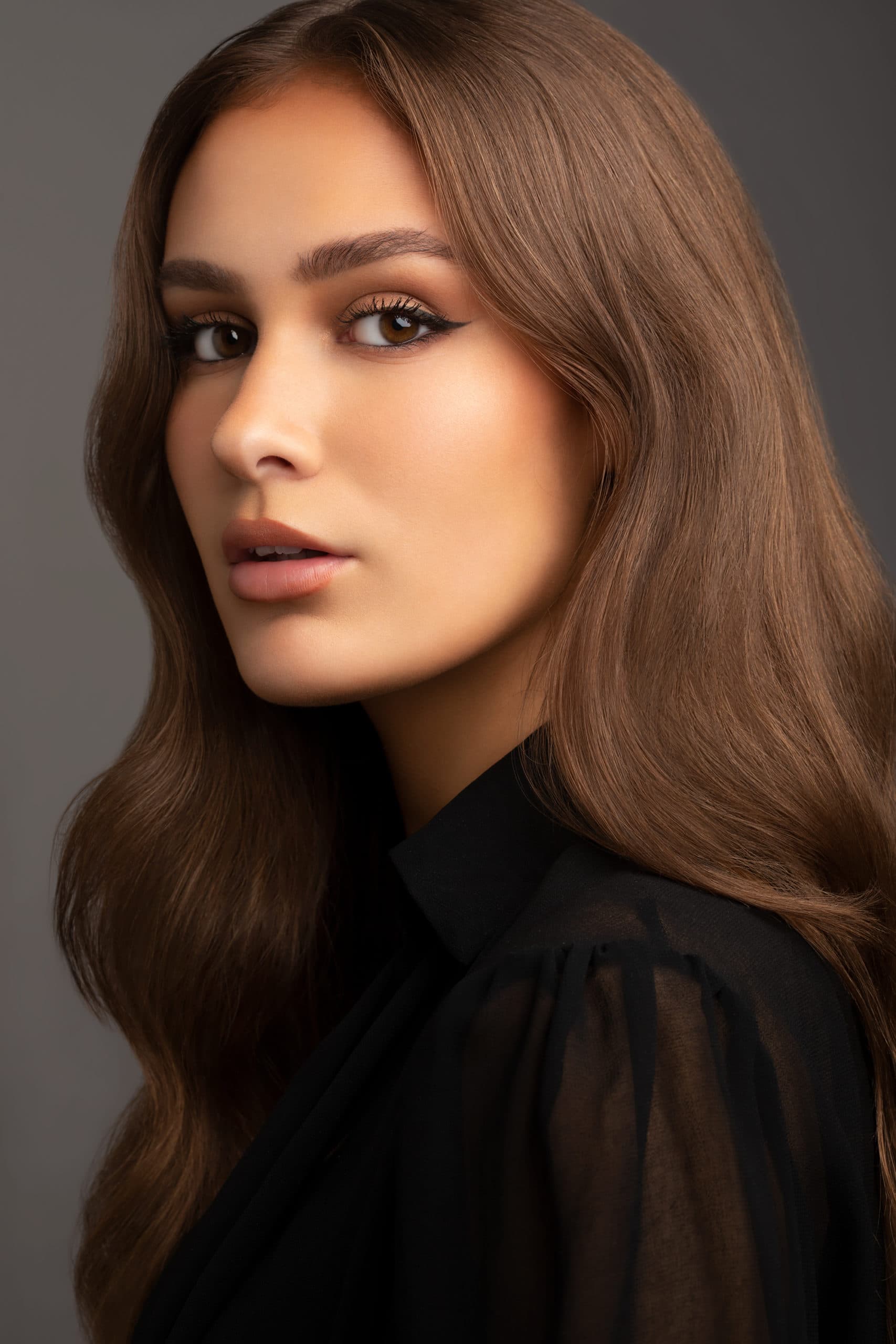
4. Eyebrows and contouring
I like to finish skin by balancing Dodge with some Burn. I add some contouring to the face in oder to enhance bone structure and contrast. I use Burn on the left eyebrow too, to make it look thicker and more similar to the other brow.
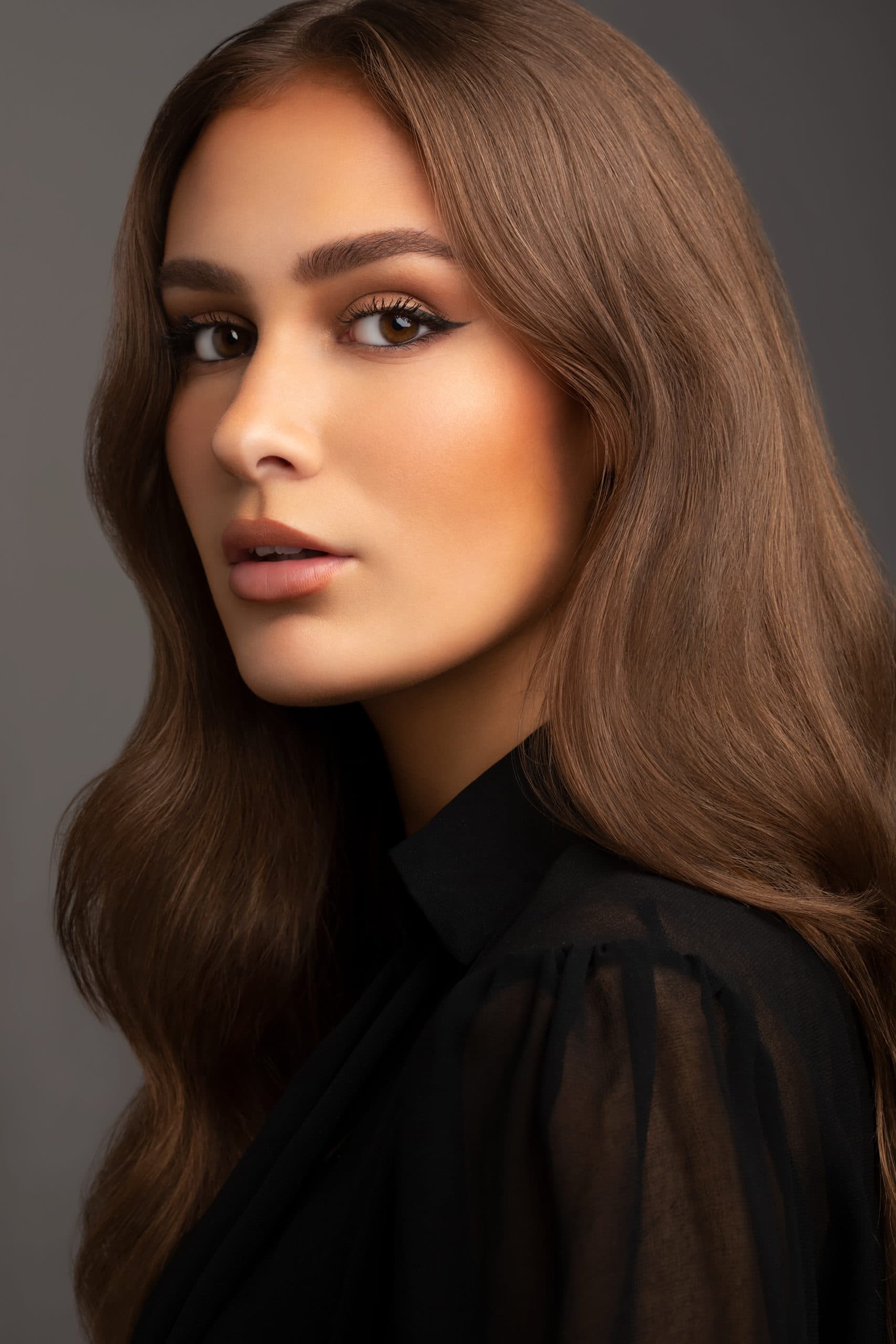
5. Eyes
I clean up the whites and subtly brighten up the inside of the eye to enhance presence. We want to be subtle with this step to avoid the image looking over-retouched. A little brightness in the eyes will go a long way.
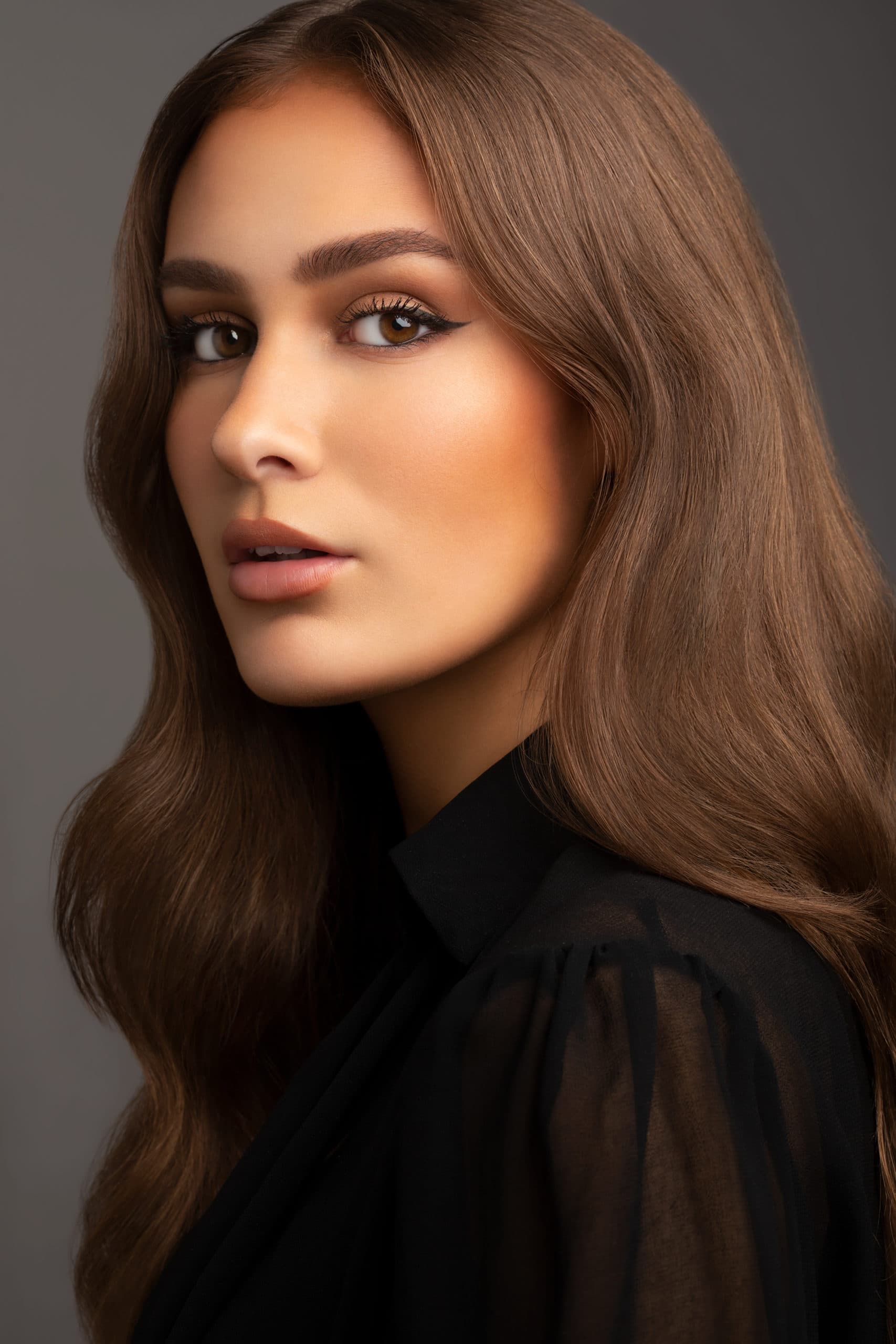
6. Colour grading
A few layers of tailored colour grading allow me to find the perfect toning for this image. In beauty shots, skin tone is always my starting point for colour grading. I choose tones that enhance skin tones by removing some of

Ten top tips for beauty and fashion photography
1. Plan ahead
Good pre-shoot planning makes for a smoother and more organised shoot that is more likely to reflect the guidelines and mood board.
2. Choose the right lens
If you shoot close-ups, use a long enough lens that won’t distort the image when in close proximity to the subject. A quality 100mm prime is ideal.
3. Hone your retouching skills
Learning to skilfully remove the right amount of distracting details will give your images the high-end look they need to attract the attention of big clients.
4. Get comfortable
Shooting beauty is a fairly static business, and all about capturing the details. Find a comfortable shooting position that allows you to have a stable hold of lens and camera.
5. Tailor the idea
On shoot day, anything you have planned beforehand needs to be adapted to the subject’s look. A skilled makeup artist and hair stylist will make the right suggestions.
6. Connect with your subject
Brief your model on arrival and chat with them to break the ice. If they are comfortable with you and have a good shoot, it will clearly show.
7. Keep it simple
The most common mistake when starting with beauty and fashion is overdoing styling and poses. Instead of adding something to the picture, ask yourself if something could be taken away. Less is more.
8. Tether
Tethering allows the whole team to view the images in real time and make adjustments to hair, makeup, lighting and more as needed. It makes a world of difference.
9. Stop and look
Every once in a while, put the camera down and review the images on the computer. Check all the details and ensure everything is in order before shooting more.
10. Work with people that you trust
Find a team of creatives who are not only talented but reliable and pleasant too. The success of a shoot is greatly impacted by the vibe on set.
Final words: Follow your passion
‘Several years ago, I scored a meeting with a photography agency. They quickly looked at my book, which was a mix of fashion and beauty work, and advised me to concentrate on shooting fashion only, and especially fashion on location. I was enjoying shooting beauty, and location work wasn’t my favourite thing, and although my heart told me a different story,
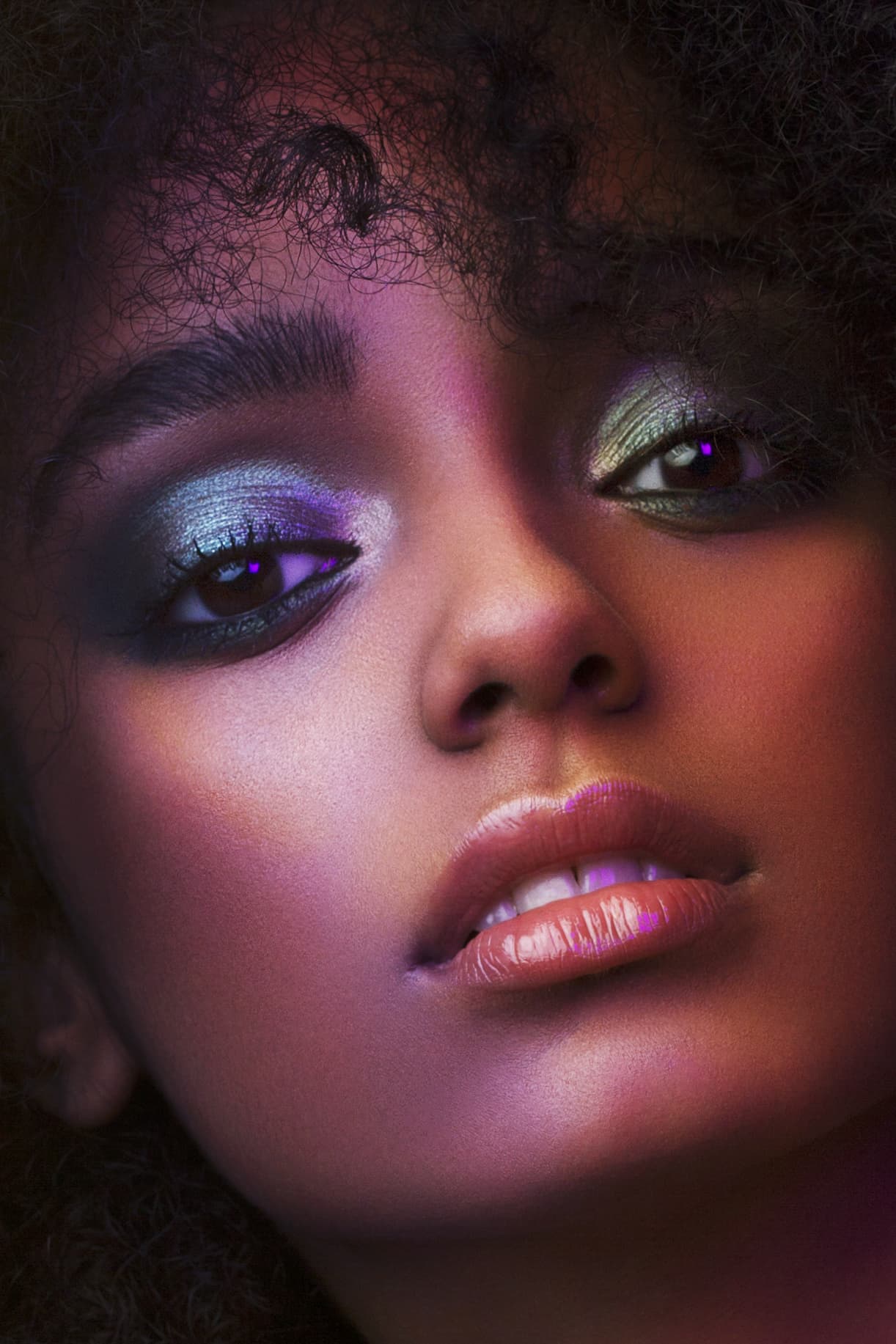
I listened to their advice. I really wanted to get signed! After a few months shooting what I was told to shoot, I got back in touch with the agency. They never replied. I dove back into beauty and instead discovered that I loved this genre with a passion. Today, my beauty work has been the most rewarding for me by far, both economically and – most importantly – creatively. Professional advice is a beautiful thing, but art comes from the heart.’
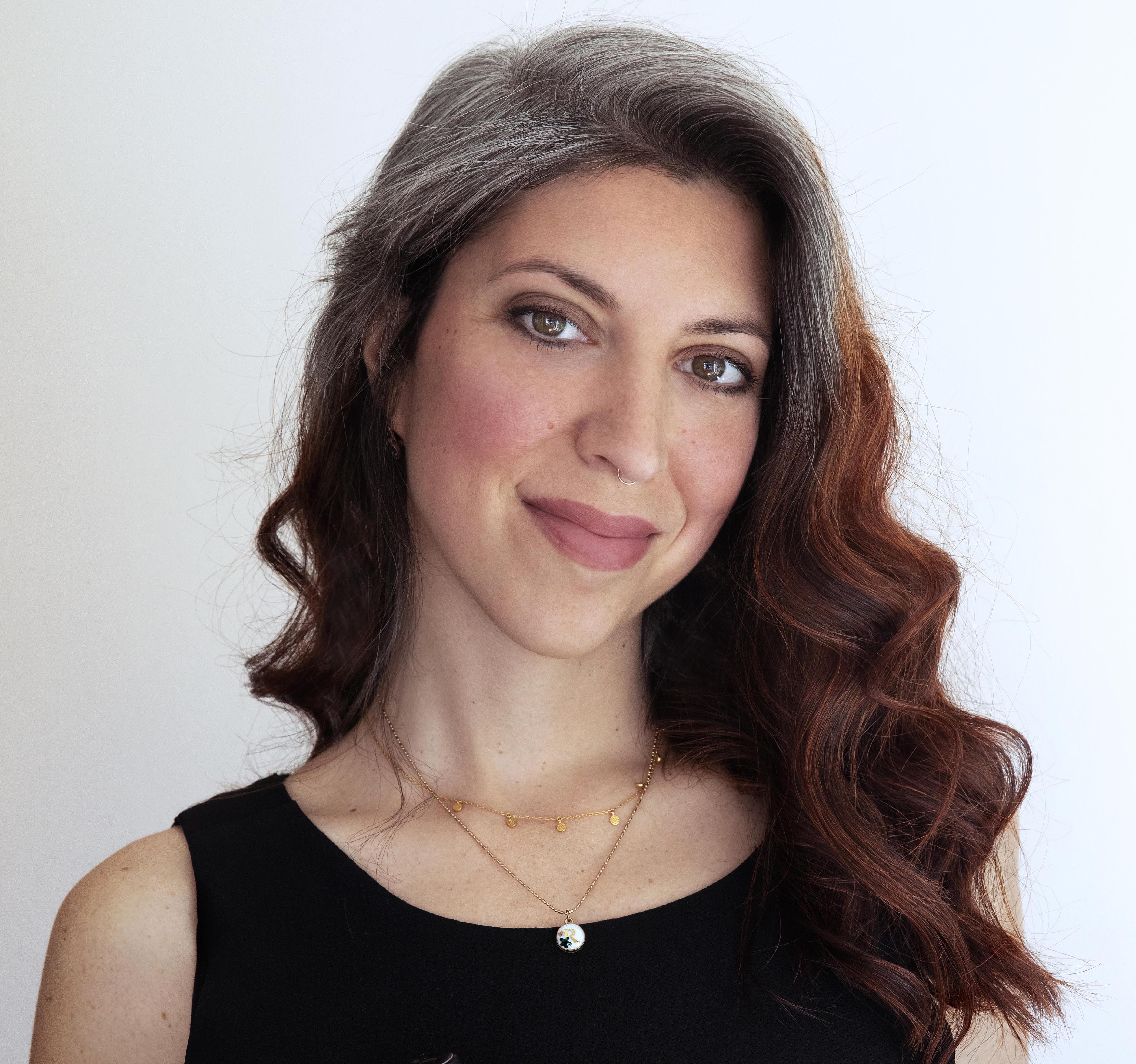
Rossella Vanon
Rossella Vanon is an award-winning beauty and fashion photographer, retoucher and educator renowned for her use of light and colour. Based in London, her clients include GHD, Lipsy and Vogue, she regularly teaches workshops and has even written a how-to book, Lighting People. See her website.
Further reading
13 quick portrait photography tips
Face time: how to shoot the same person in 50 different ways








